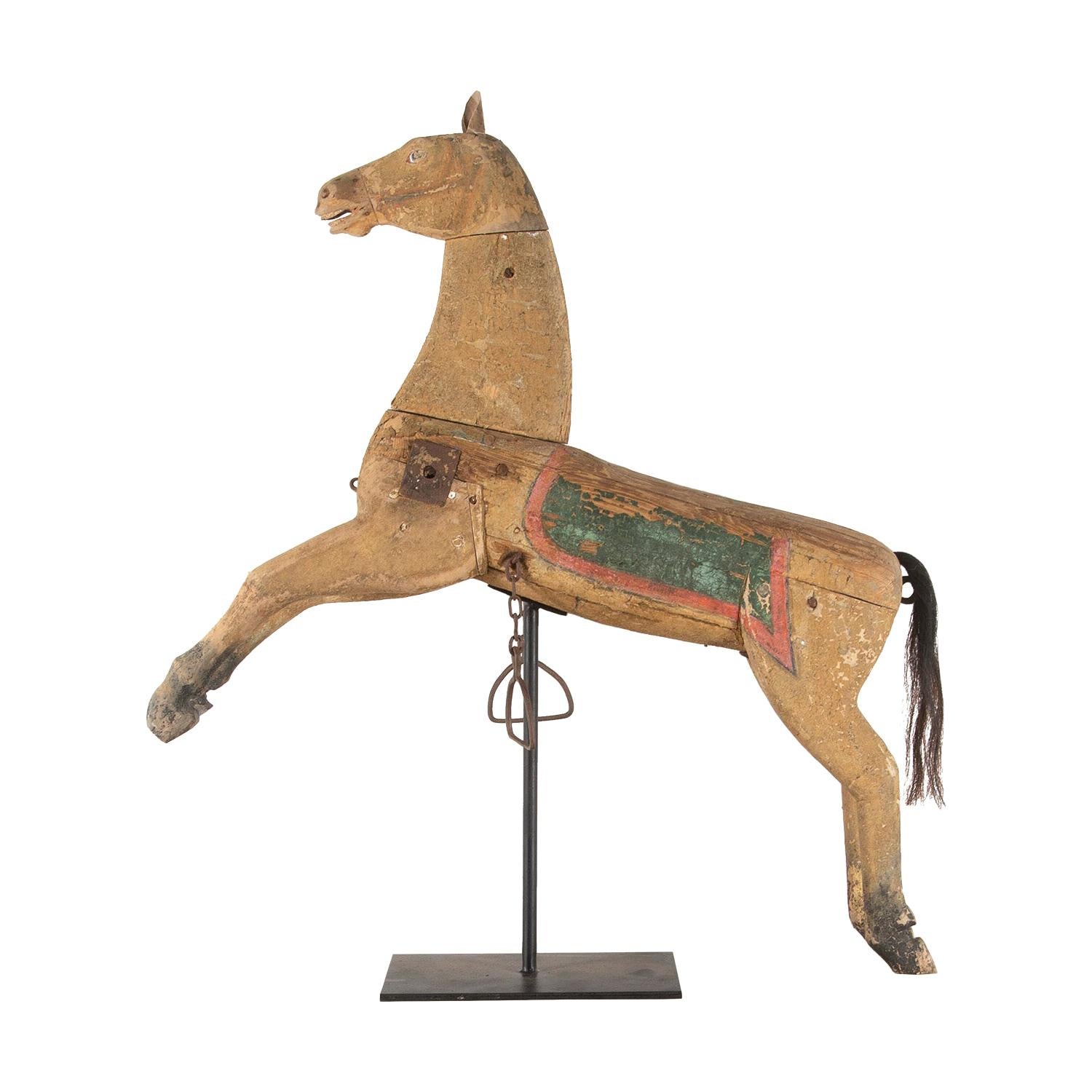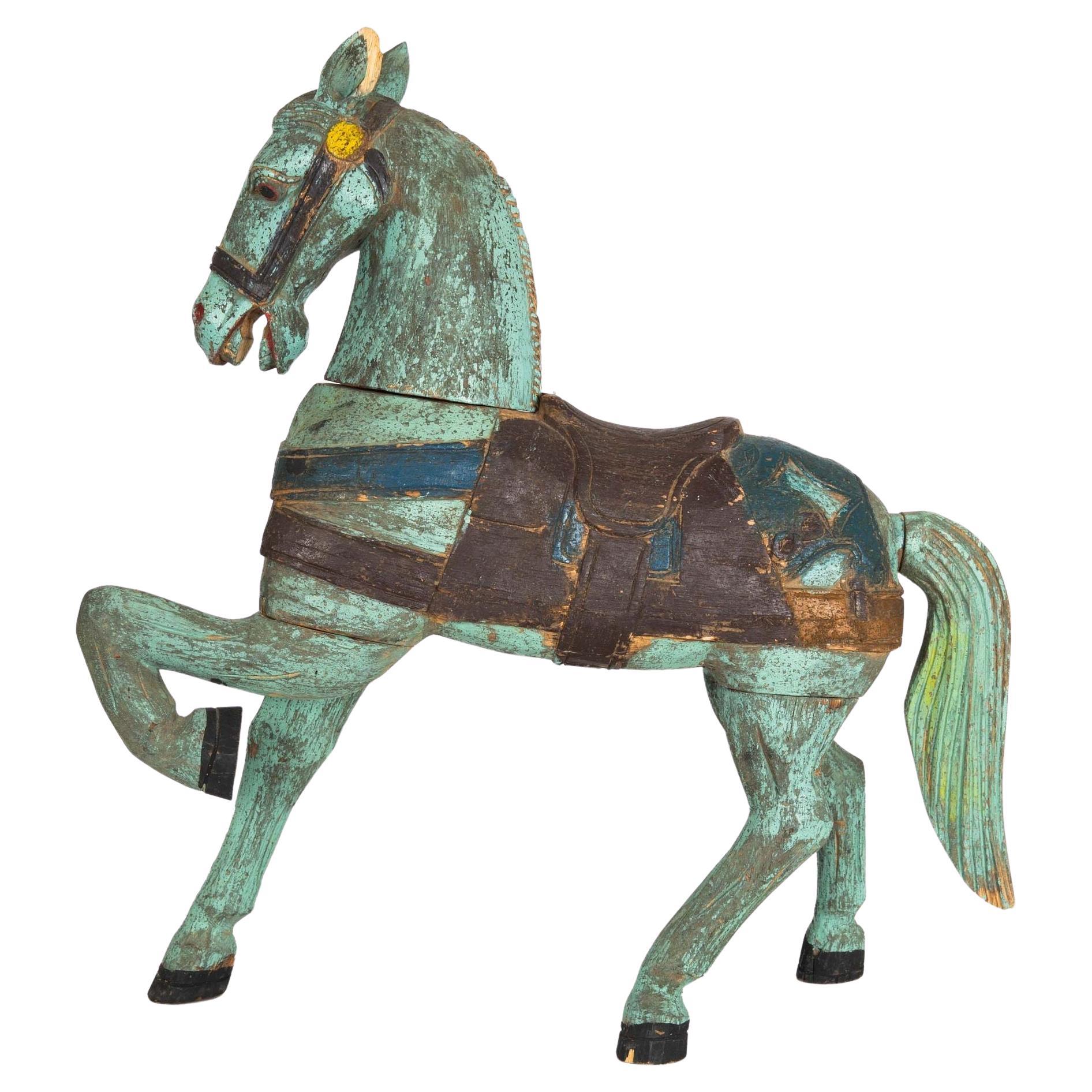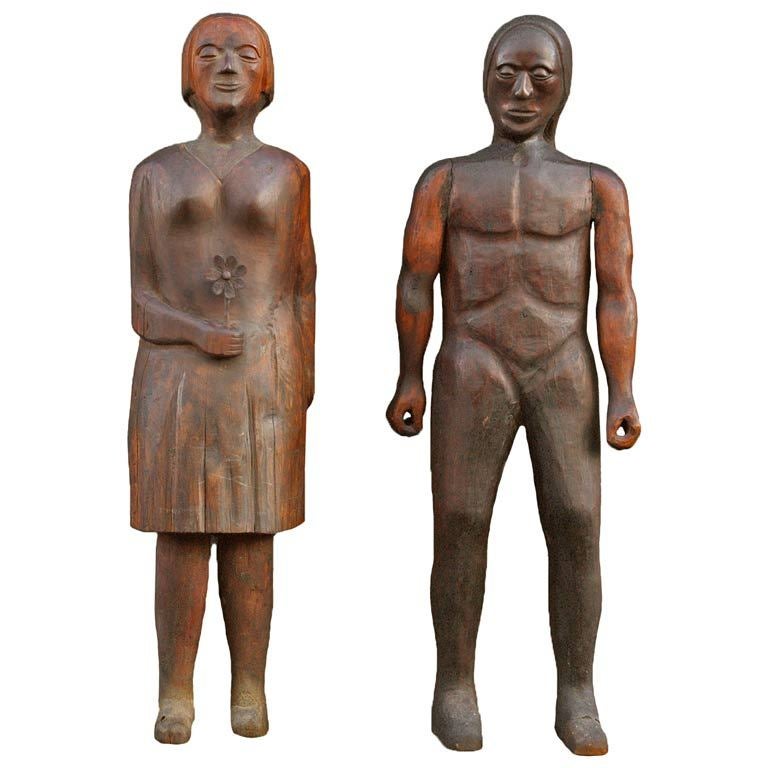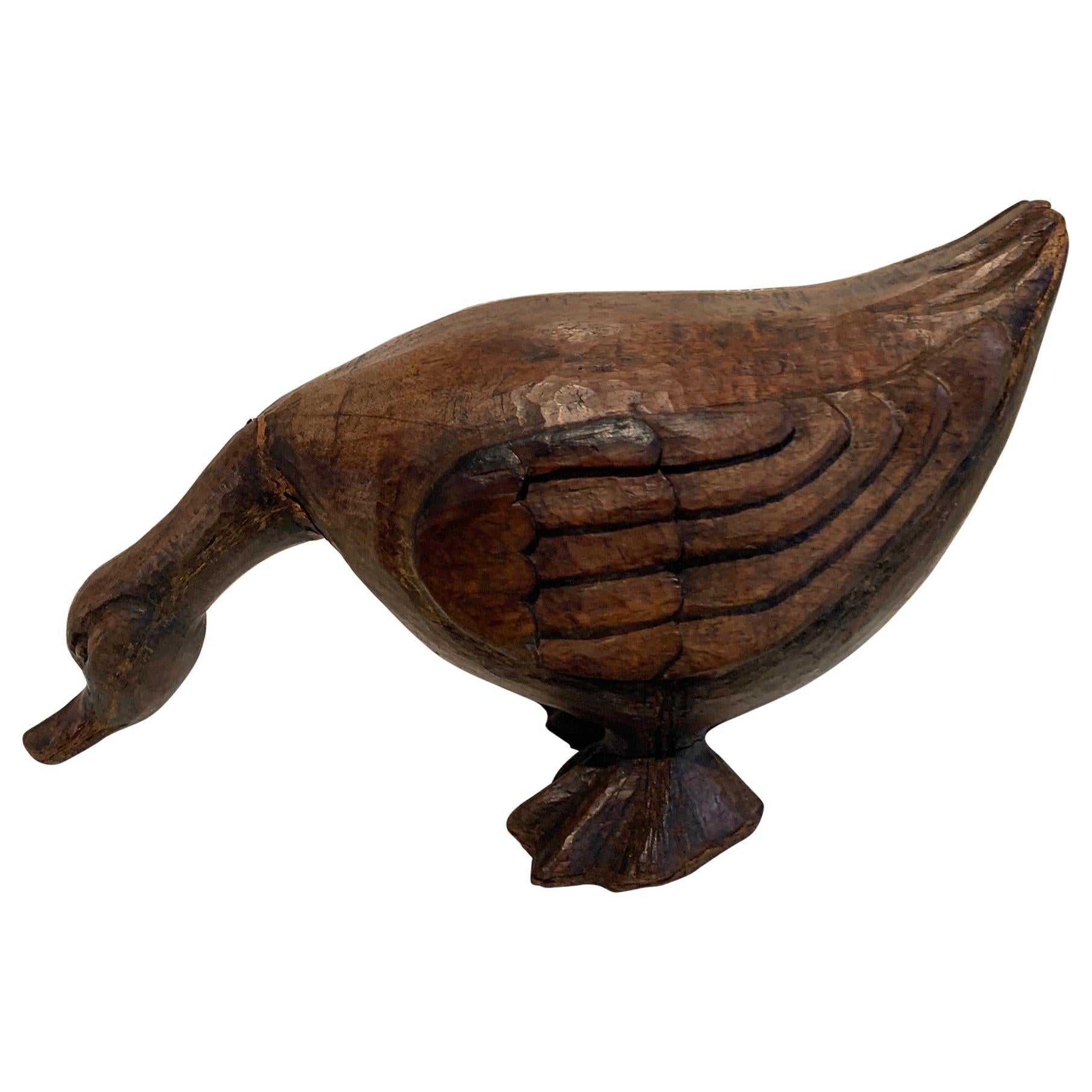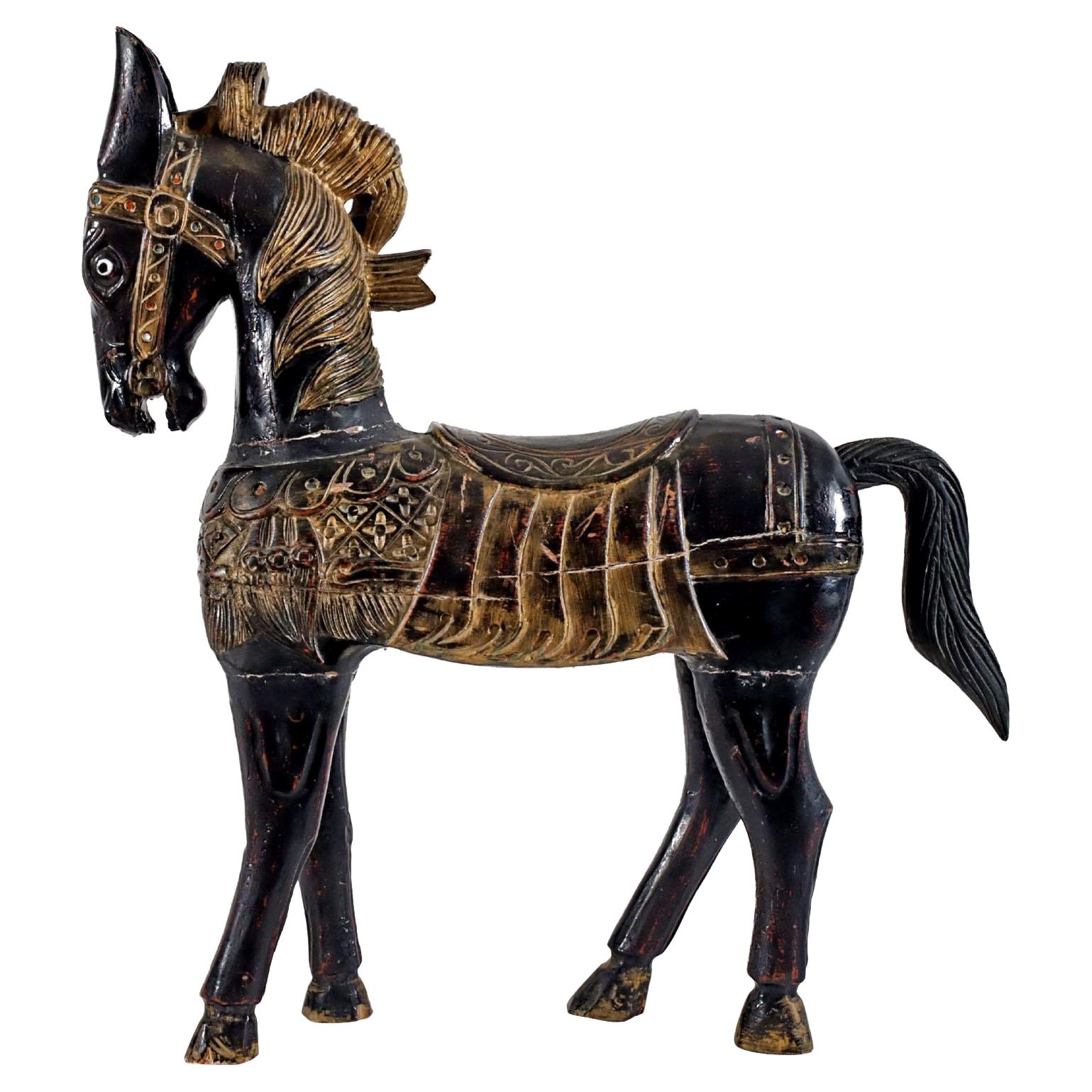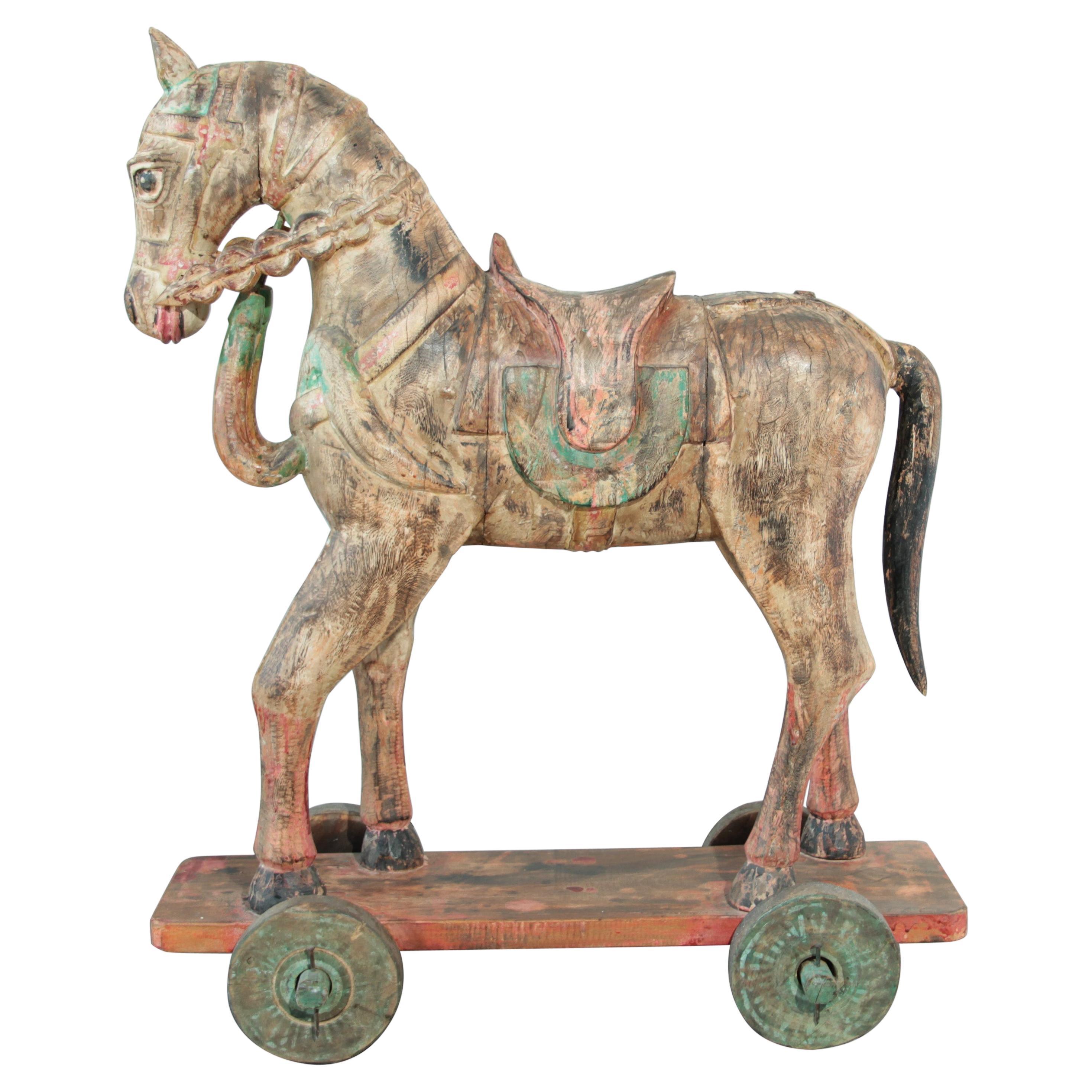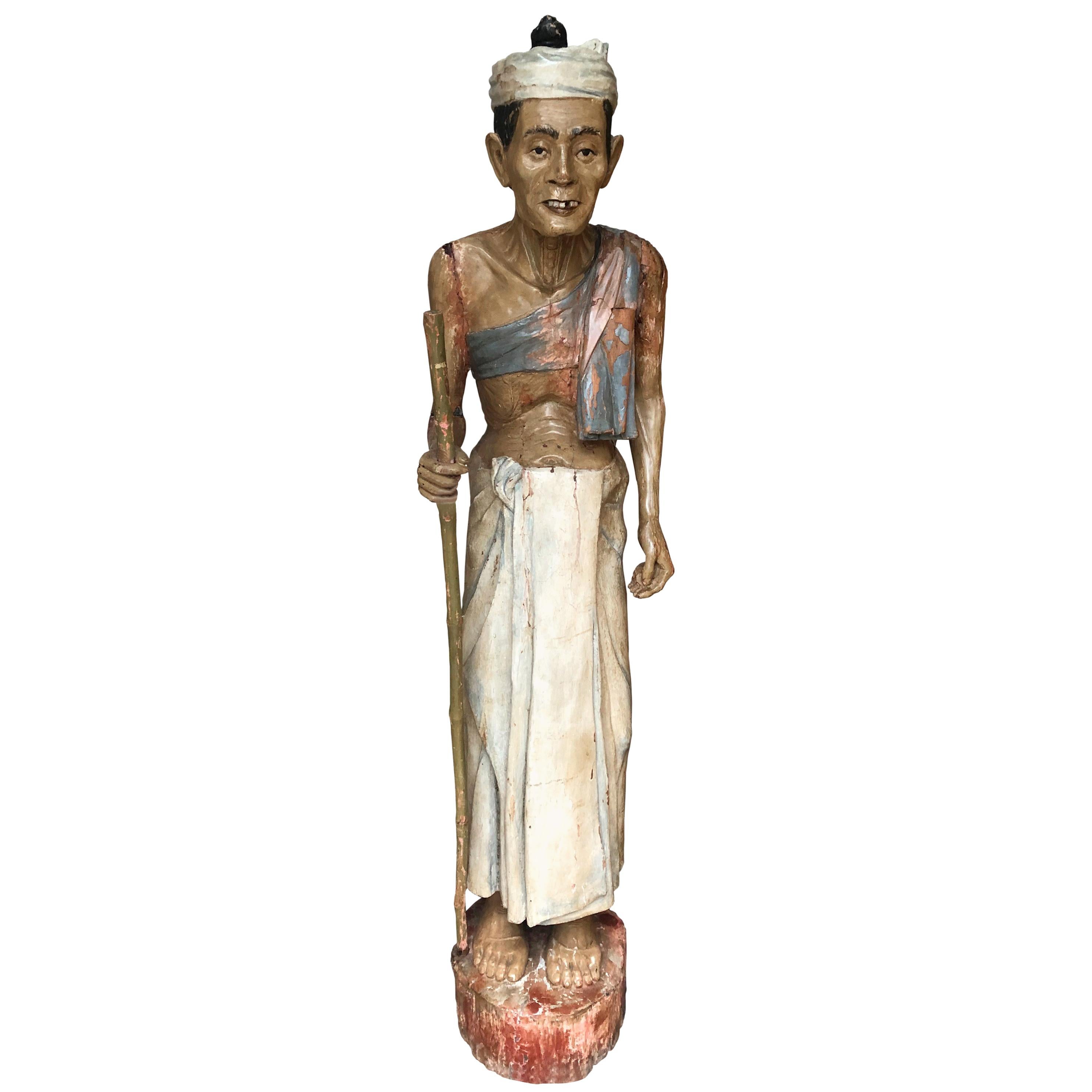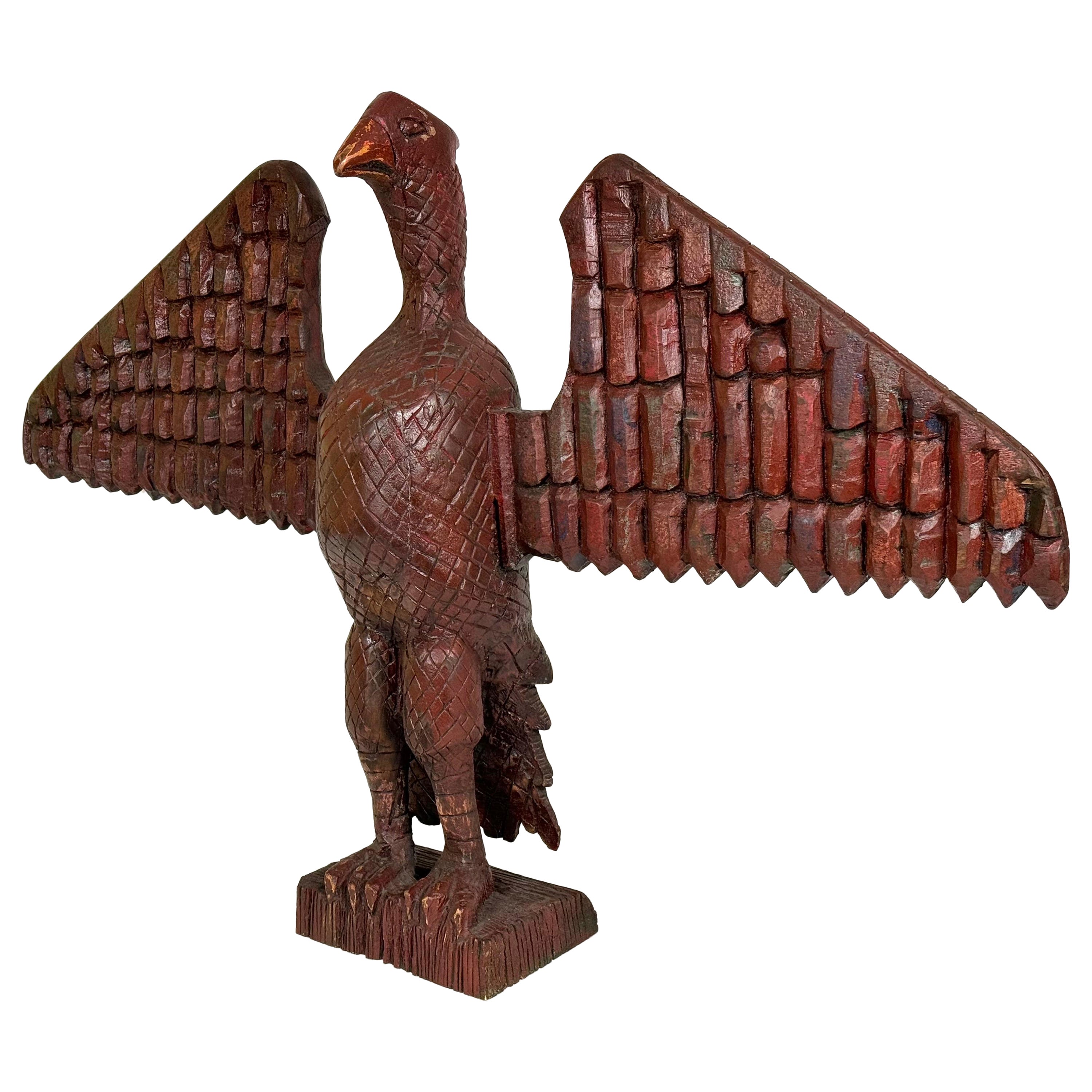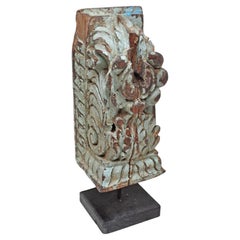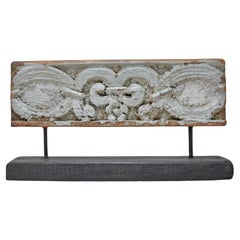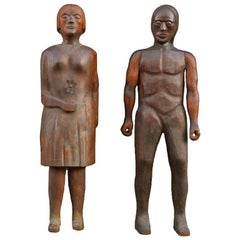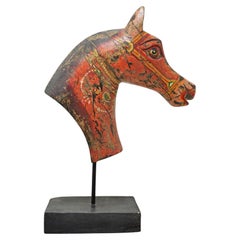
Hand-Carved and Painted Antique South Asian Folk Art Wooden Sculptural Horse Bus
View Similar Items
Want more images or videos?
Request additional images or videos from the seller
1 of 6
Hand-Carved and Painted Antique South Asian Folk Art Wooden Sculptural Horse Bus
About the Item
- Dimensions:Height: 13.6 in (34.55 cm)Width: 3.6 in (9.15 cm)Depth: 8.8 in (22.36 cm)
- Style:Primitive (In the Style Of)
- Materials and Techniques:
- Place of Origin:
- Period:
- Date of Manufacture:unknown
- Condition:Wear consistent with age and use.
- Seller Location:Leesburg, VA
- Reference Number:1stDibs: LU8166236876842
About the Seller
5.0
Vetted Seller
These experienced sellers undergo a comprehensive evaluation by our team of in-house experts.
Established in 2013
1stDibs seller since 2023
18 sales on 1stDibs
Typical response time: 3 hours
More From This SellerView All
- Original Hand-Carved South Asian Antique Architectural Bracket FragmentLocated in Leesburg, VAOriginal Hand-Carved South Asian Antique Architectural Bracket Fragment for display Anonymous Probably India; early-to-mid 20th century Wood Approximate size: 4.2 x 3.8 x 12 in. A...Category
Early 20th Century Indian Anglo-Indian Mounted Objects
MaterialsWood, Paint
- Antique Hand-Carved Architectural Wooden and White Polychrome Floral CarvingLocated in Leesburg, VAAntique Hand-Carved Architectural Wooden and White Polychrome Floral Carving Anonymous Probably South Asia; mid-20th century Wood Approximate size: 12.8 x 2.28 x 6.8 in. A South A...Category
Mid-20th Century Rustic Mounted Objects
MaterialsWood
- Antique Hand-Carved Architectural Wooden Floral Motif Panel with White PolychromLocated in Leesburg, VAAntique Hand-Carved Architectural Wooden Floral Motif Panel with White Polychrome Anonymous Probably South Asia; mid-20th century Wood Approximate size: 9.8 x 2 x 6.4 in. A South ...Category
Mid-20th Century Indian Bohemian Mounted Objects
MaterialsWood
- 19th Century Articulated Wooden Figure of the Virgin MaryLocated in Leesburg, VA19th century articulated wooden figure of the Virgin Mary Anonymous Spain; 19th century Polychrome wood, inset glass eyes Approximate size: 37 x 11 x 7 cm An antique ‘Virgin...Category
Antique 19th Century Primitive Figurative Sculptures
MaterialsGlass, Wood, Paint
- Collection of 3 South Asian Antique Architectural Fragments on StandsLocated in Leesburg, VACollection of 3 South Asian Antique Architectural Fragments on Stands Anonymous Southern Asia, probably India; first-half of the 20th c...Category
Early 20th Century Indian Archaistic Sculptures and Carvings
MaterialsWood
- Rare and important painted bronze Crucifix after a model by MichelangeloBy Michelangelo BuonarrotiLocated in Leesburg, VAA rare and very fine bronze corpus of Christ after a model by Michelangelo, cast ca. 1597-1600 by Juan Bautista Franconio and painted in 1600 by Francisco Pacheco in Seville, Spain. The present corpus reproduces a model attributed to Michelangelo. The best known example, lesser in quality, is one on display at the Metropolitan Museum of Art (MET). The association of this corpus with Michelangelo was first brought to light by Manuel Gomez-Moreno (1930-33) who studied the wider circulated casts identified throughout Spain. The attribution to Michelangelo was subsequently followed by John Goldsmith-Phillips (1937) of the MET and again by Michelangelo expert, Charles de Tolnay (1960). While Michelangelo is best known for his monumental works, there are four documented crucifixes he made. The best known example is the large-scale wooden crucifix for the Church of Santa Maria del Santo Spirito in Florence, made in 1492 as a gift for the Prior, Giovanni di Lap Bicchiellini, for allowing him to study the anatomy of corpses at the hospital there. In 1562, Michelangelo wrote two letters to his nephew, Lionardo, indicating his intention to carve a wooden crucifix for him. In 1563 a letter between Lionardo and the Italian sculptor Tiberio Calcagni, mentions this same crucifix (a sketch of a corpus on the verso of a sheet depicting Michelangelo’s designs for St. Peter’s Basillica [Palais des Beaux-Arts in Lille] may reproduce this). That Michelangelo was working on small corpora in the last years of his life is further evidenced by the small (26.5 cm) unfinished wooden crucifix located at the Casa Buonarroti, considered his last known sculptural undertaking. Michelangelo’s contemporary biographer, Giorgio Vasari additionally cites that Michelangelo, in his later years, made a small crucifix for his friend, Menighella, as a gift. Surviving sketches also indicate Michelangelo’s study of this subject throughout his career, most notably during the end of his life but also during the 1530s-40s as he deepened his spiritual roots. The occasional cameo of crucified Christ’s throughout his sketched oeuvre have made it challenging for scholars to link such sketches to any documented commissions of importance. All the while, in consideration that such objects were made as gifts, it is unlikely they should be linked with commissions. Nonetheless, a number of theories concerning Michelangelo’s sketches of Christ crucified have been proposed and some may regard the origin of the present sculpture. It has been suggested that the corpus could have its impetus with Michelangelo’s work on the Medici Chapel, whose exclusive design was given to the master. It is sensible smaller details, like an altar cross, could have fallen under his responsibility (see for example British Museum, Inv. 1859,0625.552). Others have noted the possibility of an unrealized large marble Crucifixion group which never came to fruition but whose marble blocks had been measured according to a sheet at the Casa Buonarroti. A unique suggestion is that Michelangelo could have made the crucifix for Vittoria Colonna, of whom he was exceedingly fond and with whom he exchanged gifts along with mutual spiritual proclivities. In particular, Vittoria had an interest in the life of St. Bridget, whose vision of Christ closely resembles our sculpture, most notably with Christ’s proper-left leg and foot crossed over his right, an iconography that is incredibly scarce for crucifixes. The suggestion could add sense to Benedetto Varchi’s comment that Michelangelo made a sculpted “nude Christ…he gave to the most divine Marchesa of Pescara (Vittoria Colonna).” Of that same period, two sketches can be visually linked to our sculpture. Tolnay relates it to a sketch of a Crucified Christ at the Teylers Museum (Inv. A034) of which Paul Joannides comments on its quality as suggestive of preparations for a sculptural work. Joannides also calls attention to a related drawing attributed to Raffaello da Montelupo copying what is believed to be a lost sketch by Michelangelo. Its relationship with our sculpture is apparent. Montelupo, a pupil of Michelangelo’s, returned to Rome to serve him in 1541, assisting with the continued work on the tomb of Pope Julius II, suggesting again an origin for the corpus ca. 1540. The earliest firm date that can be given to the present corpus is 1574 where it appears as a rather crudely conceived Crucifixion panel, flanked by two mourners in low-relief and integrally cast for use as the bronze tabernacle door to a ciborium now located at the Church of San Lorenzo in Padula. Etched in wax residue on the back of the door is the date, 27 January 1574, indicating the corpus would have at least been available as a model by late 1573. The Padula tabernacle was completed by Michelangelo’s assistant, Jacopo del Duca and likely has its origins with Michelangelo’s uncompleted tabernacle for the Basilica of St. Mary of the Angels in Rome. The impetus for the Padula tabernacle’s Crucifixion panel begins with a series of late Crucifixion sketches by Michelangelo, depicting a scene of Christ crucified and flanked by two mourners (see British Museum Inv. 1895.0915.510; Ashmolean Museum Inv. 1846.89, KP II 343 recto; Windsor Castle RCIN 912761 recto; and Louvre Inv. 700). A faintly traced block possibly intended for sculpting the sketch of the crucified Christ on its recto was discovered by Tolnay on a version of the composition at Windsor Castle. The Windsor sketch and those related to it appear to have served as preparatory designs for what was probably intended to become the Basilica of St. Mary’s tabernacle door. Vasari documents that the project was to be designed by Michelangelo and cast by his assistant, Jacopo del Duca. Michelangelo died before the commission was complete, though on 15 March 1565, Jacopo writes to Michelangelo’s nephew stating, “I have started making the bronze tabernacle, depending on the model of his that was in Rome, already almost half complete.” Various circumstances interrupted the completion of the tabernacle, though its concept is later revitalized by Jacopo during preparations to sell a tabernacle, after Michelangelo’s designs, to Spain for Madrid’s El Escorial almost a decade later. The El Escorial tabernacle likewise encountered problems and was aborted but Jacopo successfully sold it shortly thereafter to the Carthusians of Padula. An etched date, 30 May 1572, along the base of the Padula tabernacle indicates its framework was already cast by then. A 1573 summary of the tabernacle also describes the original format for the door and relief panels, intended to be square in dimension. However, a last minute decision to heighten them was abruptly made during Jacopo’s negotiations to sell the tabernacle to King Phillip II of Spain. Shortly thereafter the commission was aborted. Philippe Malgouyres notes that the Padula tabernacle’s final state is a mixed product of the original design intended for Spain’s El Escorial, recycling various parts that had already been cast and adding new quickly finished elements for its sale to Padula, explaining its unusually discordant quality, particularly as concerns the crudeness of the door and relief panels which were clearly made later (by January 1574). Apart from his own admission in letters to Spain, it is apparent, however, that Jacopo relied upon his deceased master’s designs while hastily realizing the Padula panels. If Michelangelo had already earlier conceived a crucifix model, and Jacopo had access to that model, its logical he could have hastily employed it for incorporation on the door panel to the tabernacle. It is worth noting some modifications he made to the model, extending Christ’s arms further up in order to fit them into the scale of the panel and further lowering his chin to his chest in order to instill physiognomic congruence. A crude panel of the Deposition also follows after Michelangelo’s late sketches and is likewise known by examples thought to be modifications by Jacopo based upon Michelangelo’s initial sculptural conception (see Malgouyres: La Deposition du Christ de Jacopo del Duca, chef-d’oeuvre posthume de Michel-Ange). Jacopo’s appropriation of an original model by Michelangelo for more than one relief on the Padula tabernacle adds further indication that the crucifix was not an object unique to Jacopo’s hand, as few scholars have posited, but rather belongs to Michelangelo’s original...Category
Antique 16th Century Renaissance Figurative Sculptures
MaterialsBronze
You May Also Like
- Folk Art Decorative Carved Wooden Horse in Original PaintLocated in Tetbury, Gloucestershire19th century carved wooden horse in original paint.Category
Antique 19th Century French Toys
MaterialsWood
- Folk Art Beautifully Hand Carved and Painted Horse Sculpture, United StatesLocated in Shippensburg, PAFOLK ART PAINTED AND CARVED WOOD HORSE 20th century, unsigned, designed to be entirely disassembled Item # 305FEB10P An incredibly fun and playful carved and painted folk art horse...Category
20th Century American Folk Art Animal Sculptures
MaterialsWood, Paint
- Hand-Carved Wooden Folk Art FiguresLocated in Santa Monica, CAKenneth Anthony Krogmeir carvings. Mr. Krogmeir was a dairy farmer from Fort Madison, Iowa. He also owned a small sawmill that he operated for personal use and for milling wood for n...Category
20th Century American Folk Art Sculptures
MaterialsWood
$12,500 / set - Hand Carved Folk Art Wooden DuckLocated in Los Angeles, CAFolk Art hand carved wooden duck - a wonderful piece! One of our favorite pieces, the life size shape and graceful angle of the neck give the p...Category
20th Century Folk Art Animal Sculptures
MaterialsWood
- Carved and Painted Wooden HorseLocated in Bochum, NRWA charming vintage hand carved wooden black horse, richly decorated and enhanced with gold accents. Used condition, some cracks and fading to the paint, otherwise good. Dimensions:...Category
20th Century European Animal Sculptures
MaterialsWood
$813 Sale Price25% Off - Antique South Asian Polychrome Wooden Oversized Ceremonial Horse from IndiaBy RajhastaniLocated in North Hollywood, CAAntique Southeast Asian Polychrome Wooden Oversized Temple Horse from India. Large Antique Southeast Asian Carved Polychrome Wood Horses. Antique Southeast Asian carved wood model of a parade horse. the body with allover polychrome, saddle and reins carved in high relief, the tail lacquered. 19th century hand carved oversized wooden Indian temple horse...Category
Antique 19th Century Indian Anglo Raj Sculptures and Carvings
MaterialsWood
Recently Viewed
View AllMore Ways To Browse
Chrome Horse Sculpture
Brass Dog Doorstop
Animal Ceramic Wall Pocket
Brass Dog Door Stop
Animal Trophy Head
Vintage Bronze Elephant Sculpture
Maitland Smith Bronze Elephant
Corner Version Zodiac
The Three Monkeys
Rooster Porcelain
Murano Large Glass Bird
Vintage Cast Iron Door Stop Dog
Vintage Ceramic Poodle Figurines
Vintage Concrete Flamingo
Vintage Donkey Toothpick Holder
Vintage Pink Flamingo Figurine
Vintage Pink Flamingo Figurines
Afghan Hound Statue
